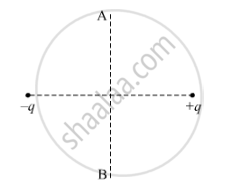Advertisements
Advertisements
Question
Let r be the distance of a point on the axis of a bar magnet from its centre. The magnetic field at such a point is proportional to
Options
`1/r`
`1/r^2`
`1/r^3`
none of these
Solution
None of these
Magnetic field B due to a bar magnet of magnetic moment M at distance r of the point on the axis of the magnet from its centre is given by
`B = (u_0)/(4pi) (2Mr)/(r^2 - l^2)^2`
Here, 2l is the length of the magnet.
So, from the above formula, it can be easily seen that `B ∝ r/(r^2 - l^2)^2`
APPEARS IN
RELATED QUESTIONS
A circular coil of 300 turns and average area 5 * 10-3m2 carries a current of 15A. Calculate the magnitude of magnetic moment associated with the coil.
A charge 'q' is moved from a point A above a dipole of dipole moment 'p' to a point B below the dipole in equatorial plane without acceleration. Find the work done in the process.

An electron in an atom revolves around the nucleus in an orbit of radius 0.53 Å. If the frequency of revolution of an electron is 9 x109 MHz, calculate the orbital angular momentum
[Given : Charge on an electron = 1.6 x 10–19 C; Gyromagnetic ratio = 8.8 x 1010 C/kg; π = 3.142]
Draw the diagrams showing the dipole moments in paramagnetic substance when external magnetic field is (a) absent (b) strong
The electron in the hydrogen atom is moving with a speed of 2.3x106 m/s in an orbit of radius 0.53 Å. Calculate the period of revolution of the electron. (Π = 3.142)
Do two distinct poles actually exist at two nearby points in a magnetic dipole?
When a current in a circular loop is equivalently replaced by a magnetic dipole,
Let r be the distance of a point on the axis of a magnetic dipole from its centre. The magnetic field at such a point is proportional to
Pick the correct options.
(a) Magnetic field is produced by electric charges only
(b) Magnetic poles are only mathematical assumptions having no real existence
(b) A north pole is equivalent to a clockwise current and a south pole is equivalent to an anticlockwise current.
(d) A bar magnet is equivalent to a long, straight current.
A horizontal circular loop carries a current that looks clockwise when viewed from above. It is replaced by an equivalent magnetic dipole consisting of a south pole S and a north pole N.
(a) The line SN should be along a diameter of the loop.
(b) The line SN should be perpendicular to the plane of the loop
(c) The south pole should be slow the loop
(d) The north pole should be below the loop
A monoenergetic (18 keV) electron beam initially in the horizontal direction is subjected to a horizontal magnetic field of 0.04 G normal to the initial direction. Estimate the up or down deflection of the beam over a distance of 30 cm (me = 9.11 × 10–31 kg).
The magnetic moment vectors µs and µl associated with the intrinsic spin angular momentum S and orbital angular momentum l, respectively, of an electron are predicted by quantum theory (and verified experimentally to a high accuracy) to be given by:
µs = –(e/m) S,
µl = –(e/2m) l
Which of these relations is in accordance with the result expected classically? Outline the derivation of the classical result.
The orbital speed of an electron orbiting around a nucleus in a circular orbit of radius 50 pm is 2.2 × 106 ms−1. Then the magnetic dipole moment of an electron is:
